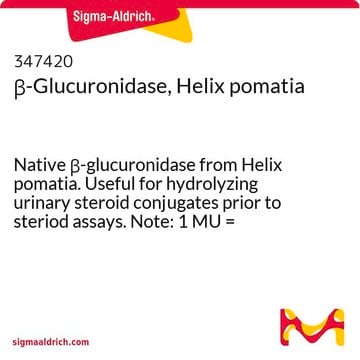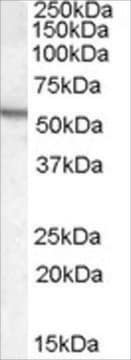BGALA-RO
Roche
β-Glucuronidase/Arylsulfatase
from Helix pomatia
Synonym(s):
arylsulfatase/β-glucuronidase, sulfatase/β-glucuronidase
About This Item
Recommended Products
biological source
animal (Helix pomatia)
Quality Level
form
solution
specific activity
10.8 U/mL, 25 °C (ß-Glucuronidase)
25 U/mL, 25 °C (with 4-NP-sulfate, Arylsulfatase)
packaging
pkg of 10 mL (10127698001)
pkg of 2 mL (10127060001)
manufacturer/tradename
Roche
technique(s)
ELISA: suitable
color
colorless to brown
optimum pH
4.5-5.0
solubility
water: miscible
application(s)
life science and biopharma
sample preparation
storage temp.
2-8°C
General description
Specificity
Specificity of β-Glucuronidase:
The glycosides that β-D-glucuronic acid forms with a variety of compounds containing hydroxyl groups hydrolyze readily in the presence of β-glucuronidase.
- Such compounds include steroids, such as estriol (Km = 0.42 mM, pH 4.5), androsterone, pregnanediol, tetrahydrocortisone,
- phenols, such as phenolphthalein (Km = 0.39 mM), 4-nitro-phenol, 4-methylumbelliferone,
- drugs such as chloramphenicol and tetrahydrocannabinols,
- and metabolites such as thyroxine and bilirubin.
β-Glucuronidase is highly specific for the carbohydrate part: neither α-glucosides nor β-glucosiduronic acids are hydrolyzed. However, the nature of the residue linked to the β-glucuronic acid residue is hardly important at all.
Specific activity: 5.5 U/ml at +38°C with phenolphthalein-β-glucuronide as the substrate (4.5 U/ml at +25°C with 4-nitro-phenyl-β-D-glucuronide as the substrate = 100,000 Fishman units/ml at +38°C with phenolphthalein-β-glucuronide as the substrate). 1 Fishman unit releases 1 μg phenolphthalein from phenolphthalein-β-glucuronide in 1 hour at +38°C.
Specificity of Acrylsulfatase:
Sulfate esters of many phenols are hydrolysed in the presence of arylsulfatase. Examples are steroid sulfates such as estronesulfate, 4-nitrophenyl hydrogen sulfate (Km = 1.8 mM, pH 7.3), 4-nitro-pyrocatechol 2-sulfate (Km = 1.25 mM, pH 7.5), and phenolphthalein disulfate.
Specific activity: 2.6 U/ml at +38°C with phenolphthalein disulfate as the substrate (14 U/ml at +25°C with 4-nitrophenyl sulfate as the substrate = 800,000 Roy units/ml at +38°C with 2-hydroxy-5-nitrophenyl sulfate as the substrate). 1 Roy unit releases 1 μg 2-hydroxy-5-nitrophenyl sulfate in 1 hour at +38°C.
The glycosides that β-D-glucuronic acid forms with a variety of compounds containing hydroxyl groups hydrolyze readily in the presence of β-glucuronidase.
- Such compounds include steroids, such as estriol (Km = 0.42 mM, pH 4.5), androsterone, pregnanediol, tetrahydrocortisone,
- phenols, such as phenolphthalein (Km = 0.39 mM), 4-nitro-phenol, 4-methylumbelliferone,
- drugs such as chloramphenicol and tetrahydrocannabinols,
- and metabolites such as thyroxine and bilirubin.
β-Glucuronidase is highly specific for the carbohydrate part: neither α-glucosides nor β-glucosiduronic acids are hydrolyzed. However, the nature of the residue linked to the β-glucuronic acid residue is hardly important at all.
Specificity of Acrylsulfatase:
Sulfate esters of many phenols are hydrolysed in the presence of arylsulfatase. Examples are steroid sulfates such as estronesulfate, 4-nitrophenyl hydrogen sulfate (Km = 1.8 mM, pH 7.3), 4-nitro-pyrocatechol 2-sulfate (Km = 1.25 mM, pH 7.5), and phenolphthalein disulfate.
Application
Features and Benefits
- Deconjugate and detect both glucuronides and sulfate esters.
- Quickly screen for steroids, benzodiazepines, cannabinoids, opioids, and other drugs.
Components
Principle
In addition, sulfation of the drug or chemical substance by sulfotransferases in the human body may occur. Sulfation in general, is less predictable than glucuronidation since many isoenzymes of sulfotransferases exist, and there are individual differences in the ratio of glucuronidation versus sulfation of the substance.
Unit Definition
Standard unit
The standard unit of β-glucuronidase activity is the enzyme activity that increases the rate of release of 4-nitrophenol from 4-nitrophenyl β-D-glucosiduronic acid at a temperature of +25 °C and pH 4.5 by 1 μM.
Phenolphthalein unit
The phenolphthalein unit of β-glucuronidase activity is the enzyme activity that increases the rate of release of phenolphthalein from phenolphthalein β-D-glucosiduronic acid at a temperature of +38 °C by 1 μM.
Approx. 4.5 standard units are equivalent to 5.5 phenolphthalein units.
Fishman unit
The Fishman unit of β-glucuronidase activity is the enzyme activity that increases the rate of release of phenolphthalein from phenolphthalein β-D-glucosiduronic acid at a temperature of +38 °C by 1 μg.
Approx. 1 standard unit is equivalent to 22,000 Fishman units (1 phenolphthalein unit is equivalent to 19,000 Fishman units).
Arylsulfatase:
Standard unit
The standard unit of arylsulfatase activity is the enzyme activity that increases the rate of release of 4-nitrophenol from 4-nitrophenyl sulfate at a temperature of +25 °C and pH 6.2 by 1 μM.
Phenolphthalein unit
The phenolphthalein unit of arylsulfatase activity is the enzyme activity that increases the rate of release of phenolphthalein from phenolphthalein disulfate at a temperature of +38 °C and pH 6.2 by 1 μM.
Approx. 5.4 standard units are equivalent to 1 phenolphthalein unit.
Roy unit
The Roy unit of arylsulfatase activity is the enzyme activity that increases the rate of release of 4-nitropyrocatechol from 2-hydroxy-5-nitrophenyl hydrogen sulfate (4-nitropyrocatechol 2-sulfate) at a temperature of +38 °C and pH 6.2 by 1 μg.
Approx. 1 standard unit is equivalent to 57,000 Roy units (1 phenolphthalein unit is equivalent to 308,000 Roy units).
Physical form
Preparation Note
Note: The present β-glucuronidase/arylsulfatase preparation is very concentrated and must be diluted for some applications. Moreover, in the preparation of protoplasts, the precise concentration to use for a given strain of yeast must be found empirically.
Storage conditions (working solution): Note: Aliquot portions of the diluted preparation may be stored at -15 to -25 °C; they should not be thawed and refrozen more than a time or two, and storage at the lower temperature does not lengthen their life beyond that of the product kept at 2 to 8 °C.
Storage and Stability
Other Notes
Storage Class Code
12 - Non Combustible Liquids
WGK
nwg
Flash Point(F)
No data available
Flash Point(C)
No data available
Certificates of Analysis (COA)
Search for Certificates of Analysis (COA) by entering the products Lot/Batch Number. Lot and Batch Numbers can be found on a product’s label following the words ‘Lot’ or ‘Batch’.
Already Own This Product?
Find documentation for the products that you have recently purchased in the Document Library.
Customers Also Viewed
Our team of scientists has experience in all areas of research including Life Science, Material Science, Chemical Synthesis, Chromatography, Analytical and many others.
Contact Technical Service











